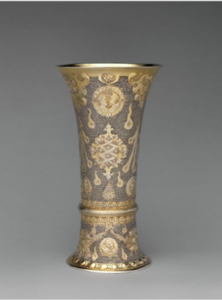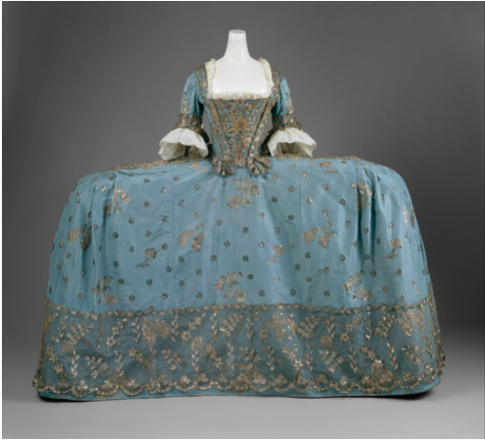Visiting The Met is probably one of the most visually pleasing things you can do! The Met is huge and it features a bunch of different exhibitions such as “Art of Native America,” “Dangerous Beauty: Medusa in Classical Art,” last but not least, “Japanese Arms and Armor from the collection of Estuko and John Morris.” My favorite part of the museum was the “Dress to Impress” collection. It consisted of so many beautiful and elegant outfits. The colors and the patterns on the outfit were absolutely vivid. You can really tell someone took their time to create these pieces. On the outfits there was detailing on the collar which made it seem like it was handmade. At the Met I looked at some renaissance and baroque pieces of art. The art piece from the renaissance collection that piqued my interest is a footed beaker. Although it looks like a vase it’s called a beaker. The cultural background that it is imported from is Hungarian, Nagyzeben. The art piece is a medium size art piece (Height: 9 13/16 in. (24.9 cm) that is silver and partially gilded. The art work is made out of metalwork- silver.  The art work itself looks like its dripping in gold. It has a really cool semi silver finish which contrasts against the gold designs. There is a thick band at the bottom which creates an illusion of two pieces rather than one whole piece. The Baroque artwork that I picked is a footed beaker with a cover. It was easier to compare two pieces of artwork which were similar in shape and design. It’s originated from Hungarian, Brasso. The artwork is a medium (15 3/4 x 6 11/16 in. (40 x 17 cm) size of gilded-silver, metal-work. The art piece had a dull gold and silver finish to it. This art work has a man in the middle with flowers/leaves around the art piece. The art piece also has a cover to this beaker. The cover has a very shiny finish to give an illusion that it is glistening.
The art work itself looks like its dripping in gold. It has a really cool semi silver finish which contrasts against the gold designs. There is a thick band at the bottom which creates an illusion of two pieces rather than one whole piece. The Baroque artwork that I picked is a footed beaker with a cover. It was easier to compare two pieces of artwork which were similar in shape and design. It’s originated from Hungarian, Brasso. The artwork is a medium (15 3/4 x 6 11/16 in. (40 x 17 cm) size of gilded-silver, metal-work. The art piece had a dull gold and silver finish to it. This art work has a man in the middle with flowers/leaves around the art piece. The art piece also has a cover to this beaker. The cover has a very shiny finish to give an illusion that it is glistening.  The difference between Renaissance and Baroque art is that most people understand that if a painting or sculpture is made in Europe between 1300 and 1600, it’s likely a Renaissance work. And, if it’s a European work made between 1600 and 1750, then it’s Baroque. … A good word for Renaissance art is “stabilize,” while a good one for the Baroque is “dramatize.”
The difference between Renaissance and Baroque art is that most people understand that if a painting or sculpture is made in Europe between 1300 and 1600, it’s likely a Renaissance work. And, if it’s a European work made between 1600 and 1750, then it’s Baroque. … A good word for Renaissance art is “stabilize,” while a good one for the Baroque is “dramatize.”



